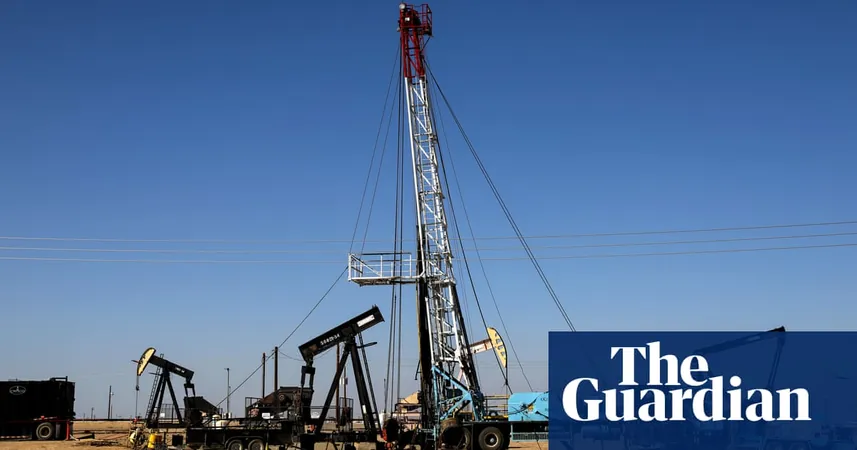
Why Trump's 'Drill, Baby, Drill' Strategy Might Not Be the Gas Price Savior He Promises
2024-11-19
Author: Kai
During the Republican National Convention held in July, Donald Trump made a bold pledge to lower gas prices by ramping up domestic oil production, exclaiming, "We will drill, baby, drill." However, experts are skeptical about whether this promise will actually lead to a drop in fuel costs for American consumers.
Despite the president-elect's declarations, the motivations of oil and gas companies suggest a different narrative. In recent years, U.S. energy producers have concentrated on maintaining profitability through cost reduction rather than escalating production. This practice involves striking a balance between meeting global energy demands and maximizing shareholder dividends. According to Lloyd Byrne, an equity analyst at Jefferies, there is little indication that this trend will change in the near term.
Lack of enthusiasm for Trump's drilling strategy is echoed by Darren Woods, the CEO of ExxonMobil. "I’m not sure how ‘drill, baby, drill’ translates into policy," he commented. During the recent UN climate summit in Azerbaijan, Woods also urged the new administration to uphold commitments to the Paris Agreement, highlighting the ongoing tension between fossil fuel production and environmental concerns.
The U.S. has retained its status as the world's top producer of oil and natural gas, currently extracting about 13.4 million barrels per day according to the Energy Information Administration. This output is expected to continue growing, even without significant new drilling on federal lands, given that domestic oil companies have already streamlined operations and focused on their most productive wells.
Peter McNally, an analyst at Third Bridge, identifies that while crude oil prices have remained stable, energy companies are still seeing increased profits due to lower operational costs and greater efficiency. Recent industry consolidation, where larger oil firms acquire smaller shale companies, has positioned those remaining players favorably amid fluctuating prices.
Despite the sentiment in favor of increasing drilling, analysts predict a cautious approach. "Nobody’s got crazy plans to be drilling at accelerated rates," McNally asserted, indicating a reluctance among producers to unleash newfound capacity given the current market conditions.
This caution contrasts sharply with behaviors from the early 2000s when energy producers faced backlash for excessive oil extraction that led to significant financial losses. The shale boom, propelled by hydraulic fracturing technologies, initially encouraged rampant spending among U.S. energy companies. Nevertheless, the global oil market faced severe disruptions, especially during the 2010s when OPEC flooded the market, resulting in prices plummeting as low as $26 per barrel, crippling many domestic producers.
The COVID-19 pandemic shifted the paradigm in the energy sector, prompting companies to tighten their belts instead of aggressively pursuing production increases. This strategic pivot has, for the first time in decades, enabled many firms to begin generating free cash flow, as noted by Rob Thummel from Tortoise Capital Advisors.
Forecasts suggest that if U.S. oil firms maintain discipline, they might see production rise by approximately 500,000 barrels per day by 2025. However, even a significant increase in crude oil production may not alleviate gas prices for consumers. U.S. refining capacity is limited, and technical specifications dictate the types of crude oil that refiners can process. Before the boom in shale oil, many refineries heavily invested in equipment to refine heavier imported oils. Transitioning to accommodate lighter shale oil would require substantial capital investments—which could ultimately lead to increased gasoline prices, as refiners aim to recoup their costs.
Thus, as refineries adjust to the new landscape, experts suggest that a lot of the potential increase in domestic shale production may need to be exported instead. This realization raises deeper questions about whether Trump's 'drill, baby, drill' mantra can genuinely fulfill its promise of lower gas prices for American drivers. It remains a contentious topic, balancing economic realities with environmental responsibilities.





 Brasil (PT)
Brasil (PT)
 Canada (EN)
Canada (EN)
 Chile (ES)
Chile (ES)
 España (ES)
España (ES)
 France (FR)
France (FR)
 Hong Kong (EN)
Hong Kong (EN)
 Italia (IT)
Italia (IT)
 日本 (JA)
日本 (JA)
 Magyarország (HU)
Magyarország (HU)
 Norge (NO)
Norge (NO)
 Polska (PL)
Polska (PL)
 Schweiz (DE)
Schweiz (DE)
 Singapore (EN)
Singapore (EN)
 Sverige (SV)
Sverige (SV)
 Suomi (FI)
Suomi (FI)
 Türkiye (TR)
Türkiye (TR)